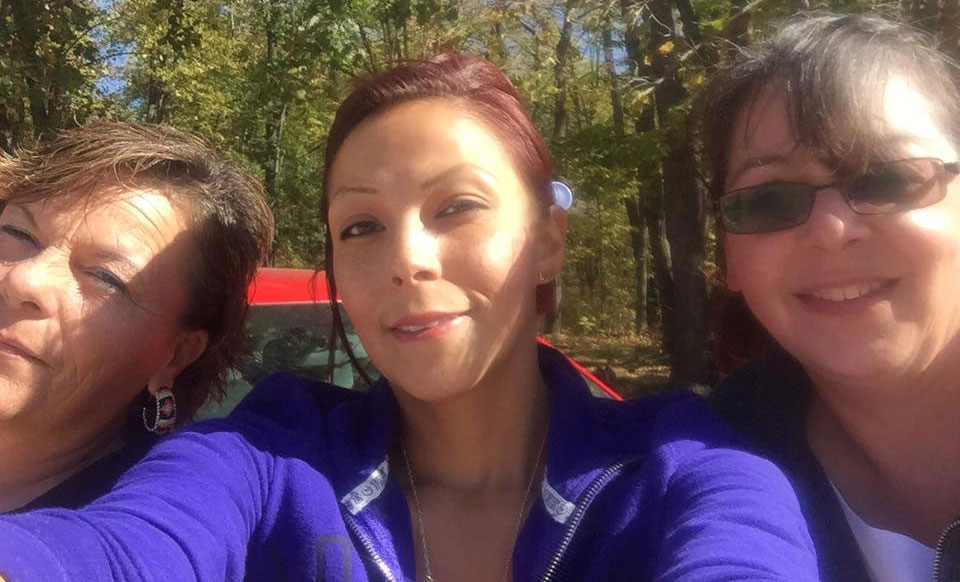
WASHINGTON—For more than two years, Darla Banks has been silent. On Jan. 17, she spoke for the first time – understandably halting to compose herself – about her daughter’s murder.
Hers is an all-too-common tale among Native Americans and indigenous people worldwide, and it helped lead to the first-ever march planned for Washington, on Jan. 18, by indigenous people who have been arriving here from as near as New York and as far as Australia.
Darla Banks is a daughter of the late Dennis Banks, one of the leaders of the American Indian Movement, the first widely noticed movement by Native Americans to gain the rights, respect, and often the lands, white colonizers and America Firsters stripped from them for centuries.
But she’s also the mother of the late Rose Downwind. And what happened to her daughter, including official response – or lack of it – happens often to Native Americans, she told a crowd at the Women’s National Democratic Club in D.C. the night before the march.
Darla Banks was always worried about her daughter’s safety with her companion, Marcello. Once, he clobbered Rose so hard, “Rose suffered a broken toe and had her fingers slammed in the door.”
And Marcello, Darla knew, previously checked himself into, and out of, a psychiatric ward. Darla Banks got into the habit of awaiting daily check-in calls from Rose. Darla also wanted to make sure her five grandchildren, Rose’s kids, were all right.
When nobody called for two days in late September 2015, Darla Banks called police. She was met with indifference, at best. Wait 72 hours, they told her, then file a missing person report. She did but that wasn’t enough. Darla, her husband, and other relatives got on a plane. “We also thought this non-Indian,” Marcello, “was trying to take the kids.”
“We went to the police, the courthouse and the shelter” for women escaping brutal relationships. “’No, we can’t help you,’ the lady at the shelter said.”
After constant prodding from the Banks family, the police finally established Rose’s home as a crime scene. But they took their time about following clues. The family put up “missing” posters and a Facebook posting. Finally, after more than two months, Marcello confessed to murder. On Dec. 9, 2015, 52 days after she disappeared, the burned body of Rose Downwind was discovered in a shallow grave near Bemidji, Minn. Dental records and an autopsy identified her.
“I know the pain and how bad it is” for other families whose mothers, sisters and daughters were sexually assaulted, disappeared or died, Darla Banks said. Some 52.6 percent of Native American women told researchers they were, at some point in their lives, sexually assaulted.
Darla Banks’s story is common in Native American communities, both in the plots of land – the federal government calls them “reservations” – they were pushed onto and in big cities, where 70 percent of Native Americans now live. The official indifference, or worse, is rampant.
Darla Banks has spent the subsequent years counseling and aiding other Native American women caught in similar circumstances. Nobody knows how many such cases of beatings, sexual violence, rape, and outright murder there are yearly of Native American women. Analysts estimate the number could be as high as 4,000 murders alone, but admit even that figure may be low.
So activists, led by Darla Banks, Davidica Little Spotted Horse, a Lakota Sioux, and Kathy Holmes, who grew up on a Sioux reservation in South Dakota, decided it is time to raise the profile of the issue, to take it from personal traumas to the national radar screen.
“Native American women have the highest rate of domestic violence, abuse, and murder” of any racial group in the nation, Little Spotted Horse told the crowd. “This march is to create awareness and a plan of action to help all who have suffered.”
“Indigenous people, especially indigenous women, need to set aside our differences and help each other,” added another march organizer, Kelly Holmes, who grew up on a South Dakota reservation.
It’s also time to raise awareness of what white invaders did to Native Americans. “We went from 100 million people to two million in just over 100 years,” added Communications Director Darren Thompson, who is conducting post-graduate research at a Minnesota university on the fates of Native Americans. His ancestors are Lac du Flambeau Ojibwe from the Great Plains and Tohono O’odham from the Southwest.
Thus the march from the Interior Department to the Lincoln Memorial on Jan. 18, followed by a day of speakers. Its organizers got a permit for 10,000-50,000 people. Ironically, at the same time he conducted the Civil War, Abraham Lincoln also had cavalry warring against Native Americans, resulting in the largest capture and the largest mass hanging in U.S. history, of 38 indigenous people in Mankato, Minn., in Dec. 1862. Lincoln pardoned another 254.
The Indigenous People’s March is the first of several marches in D.C. the weekend of Jan. 18-21. Others are the big Women’s March on Jan. 19 and a march honoring Dr. Martin Luther King Jr., on the official King Birthday Holiday, on Jan. 21. The so-called Right to Lifers are also marching on Jan. 18.
The Indigenous People’s March is also a follow-up to other instances of rising Native American activism, notably the protests against exploitation of Native American tribal lands for the controversial Dakota Access pipeline.
And it’s appropriate that Native American women took the lead in organizing the march, which comes just after the first two Native American women, ever, were elected to Congress, both as Democrats.
“We are the whole backbone of society. If women are strong, a nation is strong,” Little Spotted Horse said.












Comments